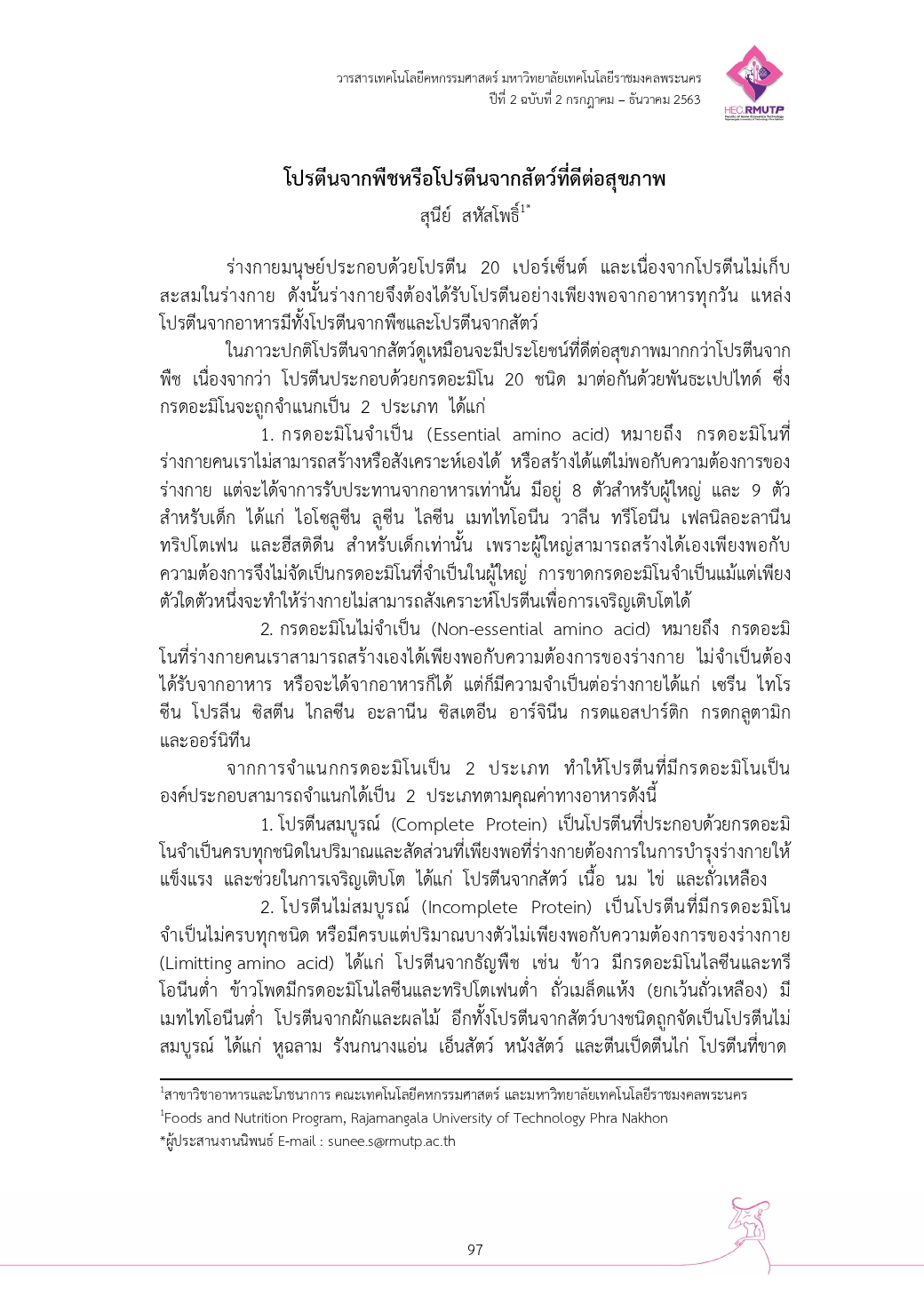โปรตีนจากพืชหรือโปรตีนจากสัตว์ที่ดีต่อสุขภาพ
Main Article Content
บทคัดย่อ
ร่างกายมนุษย์ประกอบด้วยโปรตีน 20 เปอร์เซ็นต์ และเนื่องจากโปรตีนไม่เก็บสะสมในร่างกาย ดังนั้นร่างกายจึงต้องได้รับโปรตีนอย่างเพียงพอจากอาหารทุกวัน แหล่งโปรตีนจากอาหารมีทั้งโปรตีนจากพืชและโปรตีนจากสัตว์ในภาวะปกติโปรตีนจากสัตว์ดูเหมือนจะมีประโยชน์ที่ดีต่อสุขภาพมากกว่าโปรตีนจากพืช เนื่องจากว่า โปรตีนประกอบด้วยกรดอะมิโน 20 ชนิด มาต่อกันด้วยพันธะเปปไทด์ ซึ่งกรดอะมิโนจะถูกจำแนกเป็น 2 ประเภท ได้แก่ 1. กรดอะมิโนจำเป็น (Essential amino acid) หมายถึง กรดอะมิโนที่ร่างกายคนเราไม่สามารถสร้างหรือสังเคราะห์เองได้ หรือสร้างได้แต่ไม่พอกับความต้องการของร่างกาย แต่จะได้จาการรับประทานจากอาหารเท่านั้น มีอยู่ 8 ตัวสำหรับผู้ใหญ่ และ 9 ตัว สำหรับเด็ก ได้แก่ ไอโซลูซีน ลูซีน ไลซีน เมทไทโอนีน วาลีน ทรีโอนีน เฟลนิลอะลานีนทริปโตเฟน และฮีสติดีน สำหรับเด็กเท่านั้น เพราะผู้ใหญ่สามารถสร้างได้เองเพียงพอกับความต้องการจึงไม่จัดเป็นกรดอะมิโนที่จำเป็นในผู้ใหญ่ การขาดกรดอะมิโนจำเป็นแม้แต่เพียงตัวใดตัวหนึ่งจะทำให้ร่างกายไม่สามารถสังเคราะห์โปรตีนเพื่อการเจริญเติบโตได้ 2. กรดอะมิโนไม่จำเป็น (Non-essential amino acid) หมายถึง กรดอะมิโนที่ร่างกายคนเราสามารถสร้างเองได้เพียงพอกับความต้องการของร่างกาย ไม่จำเป็นต้องได้รับจากอาหาร หรือจะได้จากอาหารก็ได้ แต่ก็มีความจำเป็นต่อร่างกายได้แก่ เซรีน ไทโรซีน โปรลีน ซิสตีน ไกลซีน อะลานีน ซิสเตอีน อาร์จินีน กรดแอสปาร์ติก กรดกลูตามิก และออร์นิทีน
Article Details
เอกสารอ้างอิง
Aemstrong B, van Merwyk AJ, Coates H. 1997. Blood Pressure in Seventhday Adventist Vegtarians. Am J Epidemiol. 105 : 444-449.
Aubertin-Leheudre M, Adlercreutz H. 2009. Relationship between animal protein intake and muscle mass index in healthy women. Br J Nutr. 102 : 1803-10.
Cotton PA, Subar AF, Friday JE, Cook A. 2004. Dietary sources of nutrients among US adults, 1994 to 1996. J Am Diet Assoc ; 104 : 921-930.
Craig WJ. 2010. Nutrition concerns and health effect of vegetarian diets. Nutr Clin Pract ; 25 : 613-620.
Gebauer SK, Psota TL, Harris WS, Kris-Etherton PM. 2006. n-3 fatty acid dietary recommendation and food sources to achieve essentiality and cardiovascular benefits. Am j Clin Nutr. 83 : 1526S-1535S.
Jenkins DJ, Wong JM, Kendall CW, Esfahani A, Ng VW, Leong TC, Faulkner DA, Vidgen E, Greaves KA, Paul G, Singer W. 2009. The effect of a plant-based low carbohydrate ( “ Eco-Atkins” ) diet on body weight and blood lipid concentrations in hyperlipidemia subjects. Arch Intern Med. 169 : 1046-54.
Lord C, Chaput JP, Aubertin-Leheudre M, Labonte M. 2007. Dietary animal protein intake : association with muscle mass index in older women. The Journal of Nutrition , Health & Aging. 11 : 383-387.
Office of Disease Prevention and Health Promotion, 2015 Dietary Guidelines Advisory Committee. Scientific Report of the 2015 Dietary Guidelines Advisory committee. Washington ( DC) : Office of Disease Prevention and Health Promotion ; 2015.
Pawlak R, Lester SE, Babatunde T. 2014. The prevalence of cobalamin deficiency among vegetarians assessed by serum vitamin B12 : a review of literature. Eur J Clin Nutr. 68 : 541-548.
Rohrmann S, Overvad K, et al. 2013. Meat consumption and mortality—results from the European Prospective Investigation into Canner and Nutrition. BMC Med.
Romagnoli E, Mascia ML, Cipriani C, Fassino V, Mazzei F, D’Erasmo E, Carnevale V, Scillitani A, Minisola S. 2008. Short and long-term varitions in serum calciotropic hormones after a single very large dose of ergocalciferol ( vitamin D2) or cholecalciferol (vitamin D3) in the elderly. J Clin Endocrinol Metad. 93 : 3015-20.
Sacks FM, Castelli WP, Donner A, Kass EH. 1975. Plasma lipids and lipoproteins in vegetarians and controls. N Engl J Med 292 : 1148-1151.
Sack FM, Rosner B, Kass EH. 1974. Blood Pressure in vegetarians. Am J Epidemiol. 100 : 390-398.
US Department of Agriculture and US Department of Health and Human Services. 2010. Report of the Dietary Guidelines Advisory Committee on the Dietary Guidelines for Americans. Washington (DC) : USDA and US Department of Health and Human Services ; 2010.


